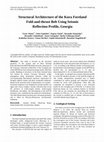Papers by Vakhtang Glonti
Geofizicheskiy Zhurnal, 2018
Введение. Локский массив входит в состав Болнисского и Дманисского административных районов Грузи... more Введение. Локский массив входит в состав Болнисского и Дманисского административных районов Грузии. Орографически он представляет собой восточную часть Южно-Грузинского нагорья и расположен на южной окраине страны (рис. 1). Южнее Локского массива, в осевой части Армянского хребта, проходит участок Грузинско-Армянской границы. На картах тектонического районирования Грузии Локский массив входит в состав Локско-Карабахской структурно-фациальной зоны [Гамкрелидзе, 2000; Adamia et al., 2011]. Массив выражен крупной антиклинальной структурой субширотного простирания,

Palaeogeography of the Sarmatian of Eastern Georgia
The limits of the Kura bay and of the adjoining tectonic high zones and depressions were inherite... more The limits of the Kura bay and of the adjoining tectonic high zones and depressions were inherited from the Middle Miocene and continued to exist. They had an important role in controlling the distribution of the sedimentary facies. The poorness in marine faunas of the Early Sarmatian deposits, together with the character of thickness and facies, suggest that these sediments formed in a big brackish basin. Towards the north and south from this basin, great mountain ranges of sublatitudinal direction existed. At the beginning of the Middle Sarmatian there were no important changes in the palaeogeographical and geotectonical situation. The basin expanded slightly towards the north, which is reflected by transgressive deposits of the Middle Sarmatian age on the northern Kakheti range (Chailuri, Manavi, Burdiani). The relatively homogeneous facies allows to suppose that the palaeogeographical and sedimentary conditions did not change for a long time. The orogenic movements, which began ...

Universal Journal of Geoscience, 2018
Our study is focused on the structural geometry of the western part of Kura foreland fold-and-thr... more Our study is focused on the structural geometry of the western part of Kura foreland fold-and-thrust belt (KFFTB) disposed in the central part of the Caucasus. Structural architecture of the Georgian part of the KFFTB has been interpreted using seismic reflection profile. Building of structures of the Kura foreland basin was formed by Greater Caucasus basement wedge propagation along detachment horizons within the cover-generating thinskinned structures represented by Neogene shallow marine and thick continental sediments. Based on the structural style of deformation, two seismicstructural complexes were identified in seismic profiles: an upper and a lower complex. Seismic reflection data reveal the presence of south-vergent thrusts, north-vergent backthrusts, and duplex. The deformations in the KFFTB structures were controlled by the multi-level detachments. The Didi Shiraki thrust-top basin has a bivergent geometry and is filled by Pliocene-Pleistocene syn-kinematic sediments.

The limits of the Kura bay and of the adjoining tectonic high zones and depressions were inherite... more The limits of the Kura bay and of the adjoining tectonic high zones and depressions were inherited from the Middle Miocene and continued to exist. They had an important role in controlling the distribution of the sedimentary facies. The poorness in marine faunas of the Early Sarmatian deposits, together with the character of thickness and facies, suggest that these sediments formed in a big brackish basin. Towards the north and south from this basin, great mountain ranges of sublatitudinal direction existed. At the beginning of the Middle Sarmatian there were no important changes in the palaeogeographical and geotectonical situation. The basin expanded slightly towards the north, which is reflected by transgressive deposits of the Middle Sarmatian age on the northern Kakheti range (Chailuri, Manavi, Burdiani). The relatively homogeneous facies allows to suppose that the palaeogeographical and sedimentary conditions did not change for a long time. The orogenic movements, which began ...
Uploads
Papers by Vakhtang Glonti